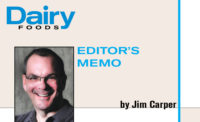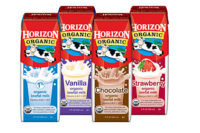In this article:Shifts in retailingAdding value to milk |
How do processors create value in a commodity item like milk? They add flavors and functional ingredients, make it more portable and seek new channels of distribution.
Despite their best efforts, unit sales of milk decreased again in the last year, to 3.9 billion units for the 52 weeks ended Aug. 12, according to market research firm Symphony/IRI, Chicago. Sales in the category totaled $11.5 billion and includes the following segments: skim/low-fat milk, whole milk, milk shakes and nondairy drinks, flavored milk/buttermilk/egg nog, and kefir/milk substitutes and soy milk.
Drinking milk for breakfast is about as old-fashioned as getting your news from the morning paper. These days, there are other options for keeping up with current events, notably iPads, smart phones, Twitter, Facebook, television and radio.
And so it goes for milk. If the family does sit down around the breakfast table, choices include nondairy beverages (soy milks and juices) and other dairy products (mainly yogurt). More likely, breakfast is granola bars and bagels eaten in a car, bus or train. The gallon jug of milk isn’t so portable.
“The trend is on the go,” said Kenneth Voelker, director of marketing for Upstate Niagara Cooperative, Buffalo, N.Y. Upstate has found success with its pints of Crave flavored milk packaged in aluminum bottles. These are sold in convenience stores, amusement parks and home improvement centers. Other dairy processors use aseptic single-serve cartons to meet the portability trend.
But fluid milk processors are not yet ready to cede breakfast to competitive beverages and foods. The Milk Processor Education Program (MilkPEP) devised an advertising and public relations campaign called The Breakfast Project to encourage milk consumption with the morning meal. MilkPEP enlisted actress Salma Hayek and celebrity TV chef Ellie Krieger to endorse milk.
A second MilkPEP campaign this year encourages gym rats and others who work out to drink chocolate milk instead of sports drinks after exercising. The Refuel With Chocolate Milk promotion used elite athletes as role models. NBA star Carmelo Anthony, Olympics swimming Dara Torres, Ironman champion Mirinda Carfrae and others lent their names to the campaign.
Low-fat chocolate milk is said to be “an economic nutritional alternative to other sports nutrition beverages to support post-endurance exercise skeletal muscle repair,” according to the website GotChocolateMilk.com.
The effort seems to have worked. Symphony/IRI and the U.S. Department of Agriculture reported a rise in sales. Symphony said sales volume for chocolate milk sold in grocery, drug, club, dollar and military outlets were up 8.3% in the 13-week-period ended Sept. 9, 2012, compared to the same period in 2011. USDA said sales of all flavored milk in July rose 8.6%.
Shamrock Farms, Phoenix, Ariz., markets a fortified milk called Rockin’ Refuel. In February, NFL running back Peyton Hills endorsed the beverage.
“Our Rockin Refuel protein-fortified milk line continues to expand in both offering and availability due to its great taste as well as athletes’ preference for a wholesome recovery beverage versus synthetic options,” said Pam Crist, Shamrock Farms brand manager. “We now offer multiple varieties of Rockin’ Refuel, including Muscle Recovery, Intense Recovery and Muscle Builder.”
The product’s properties have enabled Shamrock Farms to get a foot in the door at alternative health food channels such as GNC and Hi-Health. “This channel has a very targeted consumer base that is seeking out healthier options. Dairy products uniquely deliver on this consumer need,” Crist said.
Sassy Cow Creamery, a small dairy processor in Columbus, Wis., added a low-fat chocolate milk this summer. It sells the milk in pints, quarts and half-gallon sizes at local grocery and natural foods stores and its Farmstead Creamery. Sassy Cow uses “pure cocoa and a dash of cane sugar,” said James Baerwolf.
Shifts in retailing
Traditional grocery stores are losing market share. Increasingly, buyers are shopping at club stores and dollar stores, according to an analysis by Prime Consulting Group, Bannockburn, Ill., for MilkPEP.
Doug Adams, president of Prime Consulting Group, said that grocery stores lost 115 million gallons of milk sales in 2011, a decline of 4%. Volume at mass merchandisers (including Wal-Mart) declined 2.3% to 892 million gallons. (Sales had been increasing from 2008 to 2010.) Drug store volume, on the other hand, increased 4.8% to 128.7 million gallons.
Although they typically do not have refrigeration units, dollar stores are picking up milk business, too. Prime’s analysis shows that the number of dollar stores increased from 2010 to 2011 as did the volume per outlet. Still, the volume is small compared to convenience stores(437.6 million gallons) and club stores (284.6 million gallons). Dollar stores sold 77.5 million gallons in 2011.
Milk processors should not overlook the foodservice sector, which accounts for 14.2% of milk sales, according to Prime.
Adding value to milk
Fortifying milk with vitamins and minerals is one way in which processors add value. Then they can target specific consumer demographics. Smart Balance from Boulder Brands created three products formulated for children. The Smart Balance Kids Milks were launched in October exclusively at Harris Teeter grocery stores in the Southeast.
Recommended for children ages 12 to 24 months, Transitions Whole Milk & Nutrient Blend contains iron and prebiotics. Smart Balance says many pediatricians suggest whole milk during the transition from breast milk or formula.
Eight ounces of the Transitions milk offers 50% of the daily value of Vitamin D and 20% of the daily value of iron, said Sheryl Marchetti, Smart Balance marketing director. Regular whole milk offers 25% of the daily value of Vitamin D and 20% of the daily value of iron, she added.
In addition, Transitions Milk has DHA & EPA Omega-3s to support brain and heart health, plus prebiotics to support normal digestion.
The other two products in the line are a 2% milk and a 1% chocolate milk. Both also have added antioxidant Vitamin C and Vitamin E. All three of the milks are sold in half-gallons.
Organic milk brand Organic Valley, La Farge, Wis., is selling a non-homogenized grassmilk, said to have a “unique taste.” Milk from cows eating only grass contains naturally occurring omega-3 and conjugated linoleic acid. The company also added a 96-ounce format to its ultra-pasteurized line.
“Organic 96-ounce milk is a small segment, but is showing to be the fastest-growing organic milk segment in 2012,” said public affairs assistant Stacy Fahey. She added that omega-3 milk “continues to outperform category growth and is now 18% dollar share of the organic refrigerated fluid milk category. This leads us to believe that new enhanced milk offerings present the greatest growth opportunities in the future.”
Fluid milk processors have taken a page from their ice cream brethren who offer flavors for a limited time, usually tied to seasons or holidays. Upstate Niagara, for example, sells an Orange Scream (an orange cream flavor) at Halloween. Mint Chip, Cookies and Cream, and Birthday Cake are sold for two months then withdrawn from the market. The limited availability is intended to stimulate milk sales, Voelker said.
“The dairy industry is slow to change and to react,” he said. But he’s doing his part to move milk into new channels of distribution. By enlisting bartenders, Upstate is promoting the Crave-tini, a vodka martini made with Crave chocolate milk. It is a good product for taverns since the shelf-stable cans do not have to be refrigerated. The cans can sit on the back bar next to the liquor bottles.
Milk Processors Are Talking About:
• Chocolate milk as an alternative to sports drinks
• Keeping milk a part of breakfast
• Selling milk into new channels, like dollar stores
• Creating limited-edition seasonal flavors to create interest
• Making milk more portable (good-bye jug, hello
single-serve bottle)
Let the package sell the milk
If the nutrition of the milk inside the bottle is not a compelling enough story, focus attention on the packaging. That’s what Lehigh Valley Dairy Farms, Lansdale, Pa., did. This year, the unit of Dean Foods, Dallas, began using an opaque container developed specifically to blocking light intake. Lehigh Valley calls the package Pure Protect.
A company press release cites a Cornell University study that found that fluorescent lighting in retail display cases breaks down vitamin A and B2 (riboflavin) in bottled milk and creates flavor defects in as little as two hours.
“It’s been widely known that light can damage the flavor and nutritional integrity of milk,” said Elizabeth Fassberg, registered dietician and owner of Eat Food. “Because of this, packaging is key to protecting its taste and health benefits - including vitamin A and B2 (riboflavin).”
Lehigh Valley Dairy Farms packages whole, reduced fat, lowfat and fat-free white milk in the new bottles. Some other Dean divisions are also using the new bottle.
Milk-based drinks in restaurants include mango lassi and egg creams
By Mary Chapman, Technomic Inc.
To provide more options and healthier choices to families, many restaurants have added milk to their menus over time. The growth seems to have slowed, but the number continues to increase. Technomic’s MenuMonitor online trend-tracking resource, which analyzes the menus of more than 1,200 top chains, emerging concepts and leading independent restaurants on a continuing basis, finds 807 non-alcoholic beverages on menus in the second quarter of 2012, up 7% from 754 in the same period of 2011. The number of concepts offering milk beverages is up just a little more than 1%, to 416 from 410.
Technomic research also finds:
• Chocolate is the top flavor mentioned in the menu descriptions of non-alcohol beverages featuring milk. It accounts for 24% of items. Espresso is the No. 2 flavor, and mentioned in 19% of menu descriptions. Rounding out the top five are mocha, coffee and vanilla.
• Just less than 6% of non-alcohol beverages featuring milk are described as “non-fat” (up from 5% of beverages in 2011), 3% are “low-fat” (they were also 3% in 2011), 3% are “fat-free” (up from less than 1%), and 2% are “organic” (a figure that is flat from the prior year).
• New milky drinks added to menus include the Mango Lassi from Boloco (a regional fast-casual chain based in Boston) made with skim milk, nonfat vanilla yogurt and honey. Planet Hollywood sells an Iced Chocolate Orange Frappe made with Monin Candied Orange and dark chocolate sauce blended with ice-cold milk. New from the Maynard, Mass.-based family-dining chain 5 & Diner are Egg Creams, created with chocolate syrup, milk and soda water served with a creamy head of foam.
• Although 66% of consumers have consumed plain milk in the past 30 days, only 13% of consumers have purchased it away from home in the past month. One-quarter of consumers (25%) drank flavored milk in the past month (6% had it away from home), and 16% drank a milk substitute such as soy, rice or almond (3% away from home).
• Fully 69% of consumers associate milk with “healthy,” the same percentage who associate bottled water with “health.” That figure is higher than that for vegetable juice, fruit juice, hot tea and sports drinks.
• MenuMonitor finds several adult beverages featuring milk. In second-quarter 2012, there were 34 adult beverages with milk as an ingredient offered by 22 concepts. Thirty percent of those had chocolate flavors; 27%, vanilla; and 21%, coffee. These figures did not change measurably from the prior year.
• Likely thanks to interest in authentic global flavors, Technomic is seeing more tres leches cakes on menus. Three-unit Albuquerque, N.M.-based Mexican chain Garduno’s, for example, added the dessert, which it describes as butter cake soaked in a mixture of three different milk products, creating just the right sweetness for a rich, moist, delicious cake.
— Mary Chapman is the director of product innovation
at Technomic Inc., Chicago.










